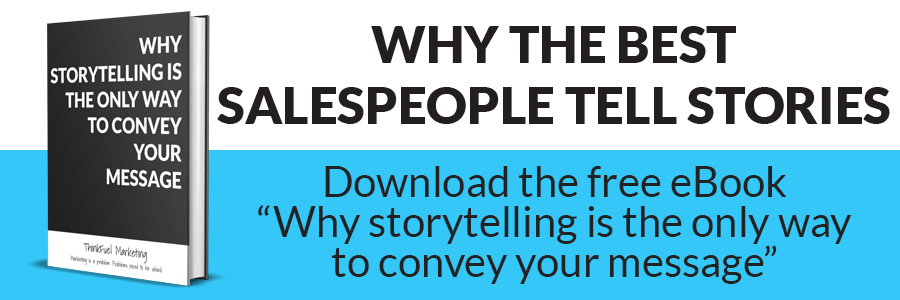Q&A Session: The Role of Storytelling In Sales & Marketing
Early this week I had the chance to catch-up with John Trimble, Vice President of Sales at Imaging Office Systems (IOS), to ask him about the role storytelling plays in sales and marketing. John and IOS have developed a strong sales methodology which heavily uses the art of storytelling.
John, you’ve been in sales leadership a long time now. Can you walk us through some of the significant changes and interesting evolutions you’ve seen over the years?
These are not unique observations, but the two most prominent differences are the role of the salesperson and also how the salesperson now engages with the prospect.
With all information known to man available on the interweb the role of the salesperson has changed – the prospect no longer needs them for product information whatsoever but conversely needs them more than ever for help in navigating the complex landscape and teaching what other very similar companies have already done and why.
As a matter of fact, the most recent survey that I have seen showed prospective buyers did not involve the salesperson until the absolute end of their buying process, spending less than 17% of the entire project time reviewing demonstrations and proposals with salespeople. All remaining time was in the buying committee or researching options individually. To make matters worse, the size of the buying committee grew -even over 2016- to an average of seven members. Merely coordinating schedules for these internal meetings led to longer decision timeframes, committees settling for “just good enough” using price as the primary metric and stripping out critical differentiators at decision time. These are all symptoms of meeting fatigue: looking for the least amount of disruption, being overwhelmed, making status quo the big winner as non-decisions happened more frequently with purchases out of committees being made only 32% of the time.
In terms of the salesperson engaging: technology has forced sales prospecting and demand creation to shift from cold calling in any form, particularly tele-prospecting and cold calling to more responsibility being placed on the company’s shoulders to perform multi-tiered marketing with in-bound drip campaigns, more sophisticated targeting, monitoring the prospect’s “journey” to define when a touch from sales will be well received and needed. This is not to say that cold calling or phone work is dead, but it is to say that the approach has to be far more nuanced and tactical than ever before.
Where do you sit on the who SPIN/Solution Selling v. the Challenger Methodology?
SPIN is dead to me. The simple reason is that – if used literally – SPIN is a transparent sales technique and obvious to the prospect. Prospects also suffer from “discovery fatigue,” and if you are the second salesperson to take them thru SPIN, their boredom can be cut with a knife. But more critically, they are reluctant to tell the truth when answering questions like “how big an issue is that for you?” knowing they are giving talking points to the salesperson sitting across the desk. My re-invention of SPIN is “SPUN,” the past tense usage indicating where SPIN actually works; the current client.
The current client has no reason to hold back information, they have already purchased from and ostensibly like you and will share freely why they made a process change, what their status quo really was costing them, on and on. This information is invaluable when applying it to similar companies you want to do business with.
Concerning Challenger Method – much of it is inarguable; prospects absolutely want to have educational conversations that “they would have paid money for” and they value sales reps for what they can learn from them, no question. That is the modern salesperson’s value-add. However, the problem is this: the premise of Challenger is that you take the prospect through a conversational journey and after showing them the current hell they should know they are in by sticking with outmoded processes etc. the Challenger Rep lifts them out of despair by telling them industry insights, savvy recommendations all specific to their industry and how others precisely like them improved their world.
No question at all that this is fabulous and also doable…but only for a limited amount of verticals. A salesperson can be bulletproof and expert on only so many applications or industries. If you are not industry or vertical-specific sales organization it becomes extremely difficult. This then places a tremendous burden on sales management to provide salespeople with compelling narratives that will be a reasonable analog for having done it all themselves. But difficult as it is it is still the best if not the only path to effective selling. It just might take a village. No, it will take a village.
How does storytelling fit into either of these models?
Storytelling is not really a component of SPIN. In the day SPIN was important because it shifted the salesperson from talking in declarative salesy sentences about their product to having the rep ask questions allowing the prospect to talk about their world. The premise of Situation/ Problem / Implication / Need was that by answering (at times endless) sequential questions, the prospect arrived at the conclusion that they needed X and wanted to buy. Questions replaced talking. Not bad for 1988.
However, now the information exchange has reversed itself and now the only value the salesperson offers to the prospect is telling – but telling about the right things. Not product, not specs obviously but informing thru narration what other companies in the exact same boat did to improve their world. The product becomes invisible. And a substantial component of that – if done well – is strategic storytelling.
You have mentioned to me before that the IOS sales team focuses heavily on storytelling, can you tell me why that is?
You will not remember statistics, facts, factoids, logos but you will always remember the gist of a well-told story. It is simply the most effective tool for actual information exchange. A well-told IOS story almost always follows the “Myth” construct where the hero (the client) is in terrible straits and then contacts IOS and brings in the wizard – the weapon that is IOS. There has to be emotional content, and something had to be decidedly at risk for the hero. The challenge is more than daunting. Finally, the story must absolutely emotionally resonate with the listener/prospect.
What inspired you to develop a sales methodology around this strategy?
If you are a prospect in a sales presentation and right after the IOS rep has asked a few questions, they lean forward in their chair and say, “Let me tell you a quick story” it is almost impossible not to become engaged. It is different, and it also touches on what binds us – everything is a story. The history of every country, all religions, all families, everything is initially presented and recalled as myth or story.
In this context – if the story is told well which means with brevity- and features a similarity to the listener there is no better context for being remembered with the end-bonus result of you being perceived as the expert. Stories also provide excellent context for client name dropping which is critical to lateral referencing and far more effective in context than on a logo-mess PowerPoint slide.
In my experience, the best storytellers in a company tend to be the owners and long-standing executive staff. This makes sense because they have lived the stories, but how do you teach a new salesperson a story in a way they buy-in to the concept, remember the story and can recite it as if it was their own?
That is a great point and a distinct challenge, there are no shortcuts. The simple rule is that until a rep has their own stories, the company stories have to be theirs and be able to be told and told well. We practice that; on sales conference calls we will say, “Tell me a manufacturing Accounts Payable story, tell me a scanning HR story…and by all that is Holy, please make it interesting.”
So, what makes a story great as opposed to being “just okay”?
Poor stories do not have an emotional connection. The ‘hero’ has to be facing something; personal embarrassment from some higher corporate level, departmental embarrassment, job performance downgrading, not fulfilling a commitment and you need to have saved him/ her from that.
Similarly, they need to achieve something significant for themselves or their higher-ups, that you helped them accomplish. Good stories do that. At IOS we like stories where something awful was pending as pain is more compelling than pleasure in storytelling. There is also no more boring word than “goals,” and we avoid that like the plague but I digress… Good stories also do not bog down in what actual products or services were provided, but rather the story focus is on the first part – the awful situation the hero/ department/company was in. That is where the connection comes from for the listener.
Do you feel telling a sales story can be conveyed efficiently when not done face-to-face? For example, over the phone or on your website.
Storytelling can absolutely be accomplished on a website, but it would likely take a different narrative form such as a video. It can be done on the phone but far less efficiently than in person… like all selling.
A central theme we have running through the ThinkFuel Marketing website is “Why should I care?”. So why should the owner of a small to mid-size business care about storytelling?
If we are talking about potential prospects, they will care if it resonates with them. In order to resonate, they have to recognize themselves in the story even if the scenario is not identical. This is why there is a need to convey the emotional mirroring of them losing something or not gaining something if they do nothing, that is critical. We also remember that people buy what other people buy.
If we are talking about someone wanting to improve sales via storytelling all I can say is that when I recently asked my number one rep why two different salespeople were not performing the response was immediate and succinct, “They don’t know the stories.”
What advice would you have for a business owner or a sales professional who wants to build up their own collection of stories?
Classify your most compelling or impressive stories in a logical way based on what you do. Make what you did for them emotionally interesting by really understanding in detail how you benefitted them. Avoid dry case study language – that is a killer. Avoid mentioning product; you are the product regardless of what you sell.
Is there anything else you think our readers should know?
All of this is getting harder – not easier. The doorway to successful selling is narrowing yet the marketing tools you need to utilize are expanding every day as is their complexity. However, something simple and ageless like skillfully relating a story is still wildly effective. If you have someone who is not doing well for you – ask them to tell you a good company sales story. While you will not be happy with what you hear you will also immediately understand the correlation.
About John Trimble
John Trimble, the Vice President of Sales with Imaging Office Systems, has managed their Sales Group since 1994. John's driving interest in Sales is the pure psychology of the discipline and the impact that specific language, structure and process can have. Despite being in the field of Sales for over 40 years, John is driven to continually evolve his knowledge and methodology, always fine-tuning his process. John is generous with his time, demonstrated by his willingness to mentor up and coming sales talent and for his contribution as a board member in various industry associations.
About Imaging Office Systems (IOS)Founded in 1972, Imaging Office Systems (IOS) is a leading provider in the document conversion and document management industry serving Fortune 500 companies, government agencies, major universities, hospitals, manufacturing companies, and a diverse cross-section of businesses throughout the Midwest. Their five offices, the over one billion documents scanned, and the three million images converted into content management systems provide IOS with the expertise to tackle any information management project regardless of the complexity.
Table of contents
Share this
You May Also Like
These Related Stories

Why Your Salespeople are Busy and Not Productive

Picking up the Phone Will Always Be Part of Prospecting

